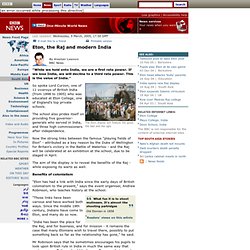

Partition The Day India Burned (Full) The British Presence in India in the 18th Century. Company rule in India. British Raj. The British Raj (rāj, lit.

"rule" in Hindi)[2] was the British rule in the Indian subcontinent between 1858 and 1947.[3] The term can also refer to the period of dominion.[3][4] The region under British control—commonly called "India" in contemporary usage—included areas directly administered by the United Kingdom[5] (contemporaneously, "British India") as well as the princely states ruled by individual rulers under the paramountcy of the British Crown. The region was less commonly also called the Indian Empire.[6] As India, it was a founding member of the League of Nations, a participating nation in the Summer Olympics in 1900, 1920, 1928, 1932, and 1936, and a founding member of the United Nations in San Francisco in 1945.[7] Geographical extent[edit] The British Raj extended over almost all present-day India, Pakistan, and Bangladesh, with exceptions such as Goa and Pondicherry.
British India and the Native States[edit] (4.) Major provinces[edit] Minor provinces[edit] Organization[edit] Anglo-Indians: Is their culture dying out? 4 January 2013Last updated at 01:46 GMT A product of the British Empire, with a mixture of Western and Indian names, customs and complexions, 2,000 Anglo-Indians are to attend a reunion in Calcutta.

But their communities in both the UK and the subcontinent are disappearing, writes Anglo-Indian Kris Griffiths. Southall in west London is home to Britain's first pub accepting rupees, railway station signs in English and Punjabi, and main thoroughfares alive all year with street food stalls, colourful saris and Bhangra music. It's my hometown, where I spent my first 20 years among the country's most concentrated population of Indians, but as one of the minority 10% white British inhabitants. Indeed, I was the only white person on my avenue in the years before I left. My mother is Anglo-Indian, raised in Jamshedpur, near Calcutta, before moving eventually to London's own "Little India". Continue reading the main story About the author Most of the Anglo-Indians were more "Anglo" than "Indian".
Eton, the Raj and modern India. "While we hold onto India, we are a first rate power.

If we lose India, we will decline to a third rate power. This is the value of India. " So spoke Lord Curzon, one of 11 viceroys of British India (from 1898 to 1905) who was educated at Eton College, one of England's top private schools. The school also prides itself on providing five governor-generals who served in India, and three high commissioners after independence. Now the strong links between the famous "playing fields of Eton" - attributed as a key reason by the Duke of Wellington for Britain's victory in the Battle of Waterloo - and the Raj will be celebrated at an exhibition at the school, due to be staged in April.
The aim of the display is to reveal the benefits of the Raj - while exposing its warts as well. Benefits of colonialism "Eton has had a link with India since the early days of British colonialism to the present," says the event organiser, Andrew Robinson, who teaches history at the school. About turn Good, bad and ugly.